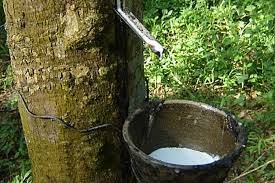Rubber is made with latex sap collected from certain trees. Latex is a sticky, milky substance which is collected by a process known as "tapping".
Natural rubber has a high resilience and stretches very well, plus it is highly waterproof.
Most natural rubber comes from the sap of the Pará rubber tree. This tree is popular because it is easy to cultivate and even when wounded by the cuts needed to collect the sap; it recovers and continues to produce the latex sap for many years.
Many trees and plants will produce latex sap but are difficult to cultivate or tap. Others require a lot of elaborate processing to get even close to usable rubber.
In 1770, Joseph Priestley, an English chemist (amongst other job titles of which he had many, each very impressive), realised that a piece of this material was very good for removing pencil marks from paper. Hence the term "rubber" which we still use today for the item otherwise known as the eraser.

Natural rubber has a high resilience and stretches very well, plus it is highly waterproof.
Most natural rubber comes from the sap of the Pará rubber tree. This tree is popular because it is easy to cultivate and even when wounded by the cuts needed to collect the sap; it recovers and continues to produce the latex sap for many years.
Many trees and plants will produce latex sap but are difficult to cultivate or tap. Others require a lot of elaborate processing to get even close to usable rubber.
In 1770, Joseph Priestley, an English chemist (amongst other job titles of which he had many, each very impressive), realised that a piece of this material was very good for removing pencil marks from paper. Hence the term "rubber" which we still use today for the item otherwise known as the eraser.